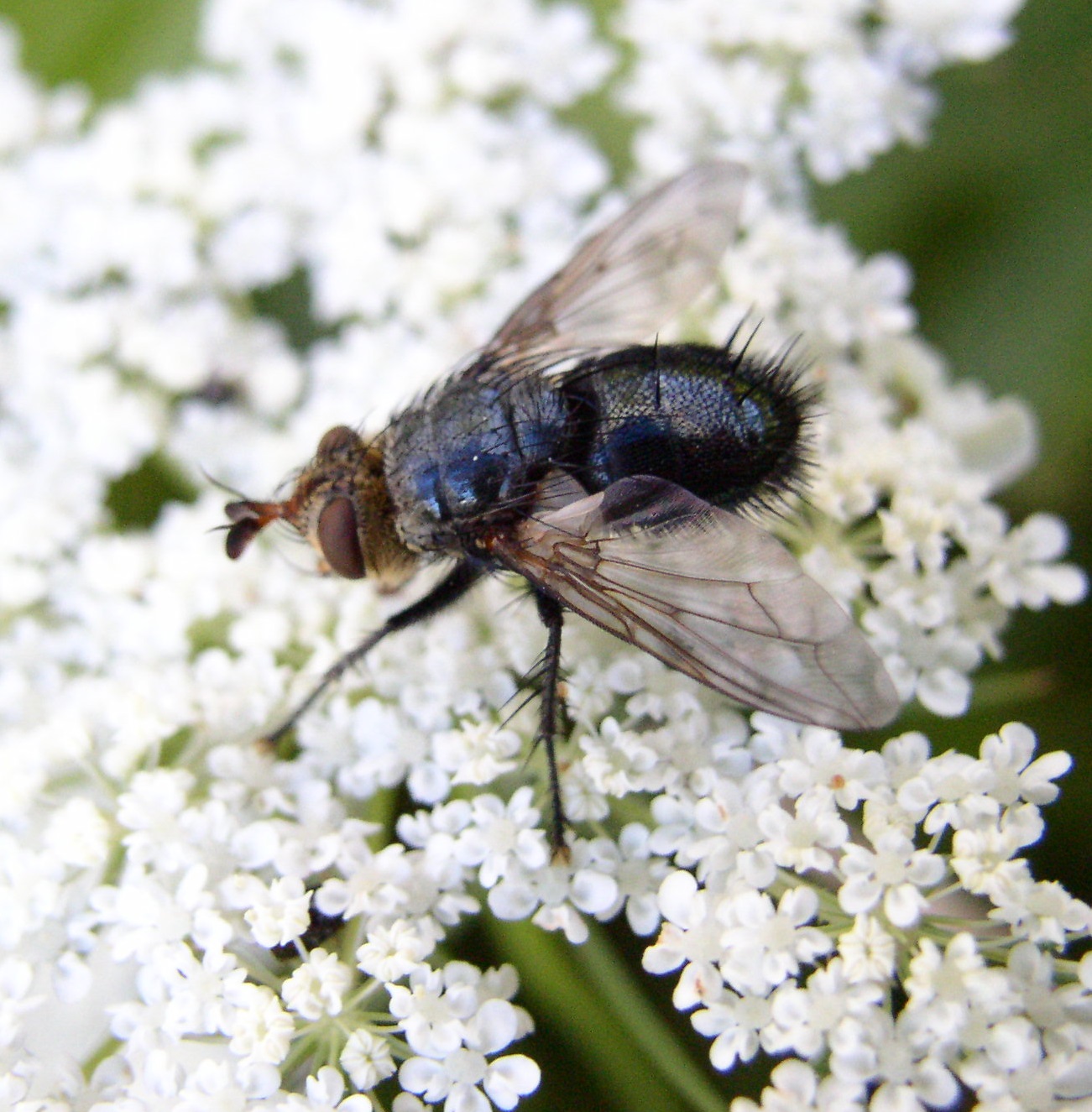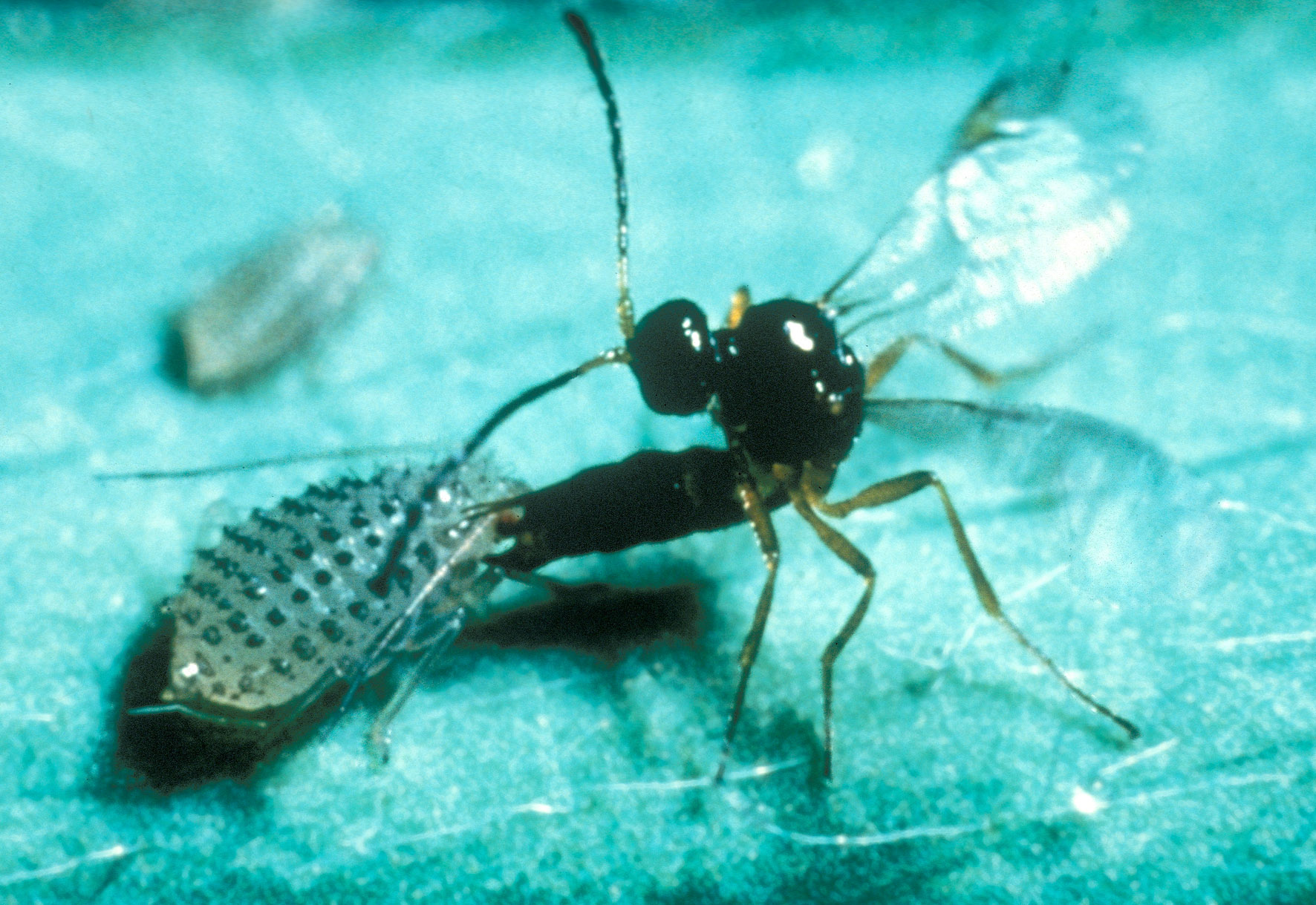|
Tachinidae
The Tachinidae are a large and variable family of true flies within the insect order Diptera, with more than 8,200 known species and many more to be discovered. Over 1,300 species have been described in North America alone. Insects in this family commonly are called tachinid flies or simply tachinids. As far as is known, they all are protelean parasitoids, or occasionally parasites, of arthropods, usually other insects. The family is known from many habitats in all zoogeographical regions and is especially diverse in South America. Life cycle Reproductive strategies vary greatly between Tachinid species, largely, but not always clearly, according to their respective life cycles. This means that they tend to be generalists rather than specialists. Comparatively few are restricted to a single host species, so there is little tendency towards the close co-evolution one finds in the adaptations of many specialist species to their hosts, such as are typical of protelean paras ... [...More Info...] [...Related Items...] OR: [Wikipedia] [Google] [Baidu] |
Dexiinae
Dexiinae is a subfamily of flies in the family Tachinidae. Tribes & genera *Tribe Dexiini **''Aglummyia'' Townsend, 1912 **'' Amphitropesa'' Townsend, 1933 **''Ateloglossa'' Coquillett, 1899 **'' Bathydexia'' Wulp, 1891 **''Billaea'' Robineau-Desvoidy, 1830 **''Callotroxis'' Aldrich, 1929 **''Camarona'' Wulp, 1891 **'' Cantrellius'' Barraclough, 1992 **''Carbonilla'' Mesnil, 1974 **'' Chaetocalirrhoe'' Townsend, 1935 **''Chaetodexia'' Mesnil, 1976 **'' Chaetogyne'' Brauer & von Bergenstamm, 1889 **''Chaetotheresia'' Townsend, 1931 **'' Charapozelia'' Townsend, 1927 **'' Cordillerodexia'' Townsend, 1927 **'' Daetaleus'' Aldrich, 1928> **'' Dasyuromyia'' Bigot, 1885 **''Dexia'' Meigen, 1826 **'' Diaugia'' Perty, 1833 **'' Dinera'' Robineau-Desvoidy, 1830 **''Dolichocodia'' Townsend, 1908 **''Dolichodinera'' Townsend, 1935 **'' Echinodexia'' Brauer & von Bergenstamm, 1893 **''Effusimentum'' Barraclough, 1992 **'' Estheria'' Robineau-Desvoidy, 1830 **'' Euchaetog ... [...More Info...] [...Related Items...] OR: [Wikipedia] [Google] [Baidu] |
Tachinid Eggs On Leptoglossus
The Tachinidae are a large and variable family of true flies within the insect order Diptera, with more than 8,200 known species and many more to be discovered. Over 1,300 species have been described in North America alone. Insects in this family commonly are called tachinid flies or simply tachinids. As far as is known, they all are protelean parasitoids, or occasionally parasites, of arthropods, usually other insects. The family is known from many habitats in all zoogeographical regions and is especially diverse in South America. Life cycle Reproductive strategies vary greatly between Tachinid species, largely, but not always clearly, according to their respective life cycles. This means that they tend to be generalists rather than specialists. Comparatively few are restricted to a single host species, so there is little tendency towards the close co-evolution one finds in the adaptations of many specialist species to their hosts, such as are typical of protelean paras ... [...More Info...] [...Related Items...] OR: [Wikipedia] [Google] [Baidu] |
Exoristinae
Exoristinae is a subfamily of flies in the family Tachinidae. Tribes & genera *Tribe Acemyini Brauer & von Bergenstamm, 1889 **'' Acemya'' Robineau-Desvoidy, 1830 **'' Atlantomyia'' Crosskey, 1977 **''Ceracia'' Rondani, 1865 **''Charitella'' Mesnil, 1957 **''Eoacemyia'' Townsend, 1926 **'' Hygiella'' Mesnil, 1957 **''Metacemyia'' Herting, 1969 *Tribe Anacamptomyiini **'' Anacamptomyia'' Bischof, 1904 **''Euvespivora'' Baranov, 1942 **'' Isochaetina'' Mesnil, 1950 **'' Koralliomyia'' Mesnil, 1950 **''Leucocarcelia'' Villeneuve, 1921 **'' Parapales'' Mesnil, 1950 *Tribe Blondeliini **'' Admontia'' Brauer & Bergenstamm, 1889 **'' Afrolixa'' Curran, 1939 **''Angustia'' Sellers, 1943 **''Anisia'' Wulp, 1890 **'' Anoxynops'' Townsend, 1927 **''Belida'' Robineau-Desvoidy, 1863 **''Biomeigenia'' Mesnil, 1961 **''Blondelia'' Robineau-Desvoidy, 1830 **''Calodexia'' van der Wulp **''Calolydella'' Townsend, 1927 **''Celatoria'' Coquillett, 1890 **''Chaetonodexodes'' Townsend, 1 ... [...More Info...] [...Related Items...] OR: [Wikipedia] [Google] [Baidu] |
Tachininae
Tachininae is a subfamily of flies in the family Tachinidae. Tribes & genera *Tribe Ernestiini :*''Appendicia'' Stein, 1924 :*''Cleonice'' Robineau-Desvoidy, 1863 :*''Eloceria'' Robineau-Desvoidy, 1863 :*'' Ernestia'' Robineau-Desvoidy, 1830 :*''Eurithia'' Robineau-Desvoidy, 1844 :*''Fausta'' Robineau-Desvoidy, 1830 :*''Gymnocheta'' Robineau-Desvoidy, 1830 :*''Hyalurgus'' Brauer & Bergenstamm, 1893 :*'' Loewia'' Egger, 1856 :*'' Zophomyia'' Macquart, 1835 *Tribe Graphogastrini :*''Graphogaster'' Rondani, 1868 :*''Phytomyptera'' Rondani, 1845 *Tribe Leskiini :*'' Aphria'' Robineau-Desvoidy, 1830 :*'' Bithia'' Robineau-Desvoidy, 1863 :*''Demoticus'' Macquart, 1854 :*''Leskia'' Robineau-Desvoidy, 1830 :*'' Solieria'' Robineau-Desvoidy, 1848 *Tribe Linnaemyini :*''Chrysosomopsis'' Townsend, 1916 :*''Linnaemya'' Robineau-Desvoidy, 1830 :*''Lydina'' Robineau-Desvoidy, 1830 :*''Lypha'' Robineau-Desvoidy, 1830 *Tribe Macquartiini :*''Anthomyiopsis'' Townsend, 1916 ... [...More Info...] [...Related Items...] OR: [Wikipedia] [Google] [Baidu] |
Gymnosoma
''Gymnosoma'' is a genus of flies in the family Tachinidae. The name ''"Gymnosoma"'' literally translates as "naked body", and presumably refers to the fact that some species in the genus are less conspicuously bristly than most species of flies in the family Tachinidae. Species *'' G. acrosterni'' Kugler, 1971 *'' G. amplifrons'' (Brooks, 1946) *'' G. brachypeltae'' Dupuis, 1961 *'' G. brevicorne'' Villeneuve, 1929 *'' G. canadense'' (Brooks, 1946) *'' G. carpocoride'' Dupuis, 1961 *'' G. clavatum'' ( Rohdendorf, 1947) *'' G. costatum'' (Panzer, 1800) *'' G. desertorum'' ( Rohdendorf, 1947) *'' G. dolycoride'' Dupuis, 1961 *'' G. emdeni'' (Mesnil, 1950) *'' G. filiola'' Loew, 1872 *'' G. fuliginosum'' Robineau-Desvoidy, 1830 *'' G. hemisphaericum'' ( Geoffroy, 1785) *'' G. hamiense'' Dupuis, 1966 *'' G. indicum'' Walker, 1853 *'' G. inornatum'' Zimin, 1966 *'' G. iranicum'' (Zimin, 1966) *'' G. majae'' (Zimin, 1966) *'' G. maxima'' Dupuis, 1966 *'' G. nitens'' Meigen, 1824 ... [...More Info...] [...Related Items...] OR: [Wikipedia] [Google] [Baidu] |
Tachina Fera
''Tachina fera'' is a species of fly in the genus ''Tachina'' of the family Tachinidae. It was first described by Carl Linnaeus in 1761. Distribution This species can be found in the entire Palearctic realm, across Europe as far north as Scandinavia and European Russia. It is also present in Israel and North Asia, east to China, Mongolia, Korea, and Japan, and in North Africa. Habitat These flies inhabit the vegetation of humid regions, meadows, woodland, forests, forest edges, clearings, heath and moorland and natural gardens. Description ''Tachina fera'' can reach a length of , with a wingspan of 16–27 mm. These tachinids show a grayish upperside of the thorax, due to dense pollinosity, with regular black stripes. The abdomen is yellow orange with a wide black dorsal stripe ending in a point . They are bristly on the thorax and abdomen, especially towards the tip, where they have long thorn-shaped, protruding black bristles. Close to the thorax there is a striking, ... [...More Info...] [...Related Items...] OR: [Wikipedia] [Google] [Baidu] |
Phasiinae
Phasiinae is a subfamily of flies in the family Tachinidae. The members of this subfamily attack only Heteroptera. Tribes & genera The subfamily Phasiinae contains the following tribes and genera: ; Tribe Catharosiini : '' Catharosia'' Rondani, 1868 : ''Stackelbergomyia'' Rohdendorf, 1948 ; Tribe Cylindromyiini : ''Argyromima'' Brauer & von Bergenstamm, 1889 : ''Australotachina'' Curran, 1834 : '' Bellina'' Robineau-Desvoidy, 1863 : '' Besseria'' Robineau-Desvoidy, 1830 : '' Catapariprosopa'' Townsend, 1927 : '' Cylindromyia'' Meigen, 1803 : '' Hemyda'' Robineau-Desvoidy, 1830 : '' Huttonobesseria'' Curran, 1927 : '' Lophosia'' Meigen, 1824 : '' Mesniletta'' Herting, 1979 : '' Neobrachelia'' Townsend, 1931 : ''Neolophosia'' Townsend, 1939 : '' Phania'' Meigen, 1824 : ''Phasiocyptera'' Townsend, 1927 : ''Polistiopsis'' Townsend, 1915 : '' Polybiocyptera'' Guimarães, 1979 : '' Pygidimyia'' Crosskey, 1967 ; Tribe Euscopoliopterygini : ''Euscopoliopteryx'' Towns ... [...More Info...] [...Related Items...] OR: [Wikipedia] [Google] [Baidu] |
Ovoviviparous
Ovoviviparity, ovovivipary, ovivipary, or aplacental viviparity is a term used as a "bridging" form of reproduction between egg-laying oviparous and live-bearing viviparous reproduction. Ovoviviparous animals possess embryos that develop inside eggs that remain in the mother's body until they are ready to hatch. The young of some ovoviviparous amphibians, such as '' Limnonectes larvaepartus'', are born as larvae, and undergo further metamorphosis outside the body of the mother. Members of genera '' Nectophrynoides'' and '' Eleutherodactylus'' bear froglets, not only the hatching, but all the most conspicuous metamorphosis, being completed inside the body of the mother before birth. Among insects that depend on opportunistic exploitation of transient food sources, such as many Sarcophagidae and other carrion flies, and species such as many Calliphoridae, that rely on fresh dung, and parasitoids such as tachinid flies that depend on entering the host as soon as possible ... [...More Info...] [...Related Items...] OR: [Wikipedia] [Google] [Baidu] |
Parasitoid
In evolutionary ecology, a parasitoid is an organism that lives in close association with its host (biology), host at the host's expense, eventually resulting in the death of the host. Parasitoidism is one of six major evolutionarily stable strategy, evolutionary strategies within parasitism, distinguished by the fatal prognosis for the host, which makes the strategy close to predation. Among parasitoids, strategies range from living inside the host (''endoparasitism''), allowing it to continue growing before emerging as an adult, to Paralysis, paralysing the host and living outside it (''ectoparasitism''). Hosts can include other parasitoids, resulting in hyperparasitism; in the case of oak galls, up to five levels of parasitism are possible. Some parasitoids Behavior-altering parasite, influence their host's behaviour in ways that favour the propagation of the parasitoid. Parasitoids are found in a variety of Taxon, taxa across the insect superorder Endopterygota, whose compl ... [...More Info...] [...Related Items...] OR: [Wikipedia] [Google] [Baidu] |
Gynaephora Groenlandica
''Gynaephora groenlandica'', the Arctic woolly bear moth, is an erebid moth native to the High Arctic in the Canadian archipelago, Greenland and Wrangel Island in Russia. It is known for its slow rate of development, as its full caterpillar life cycle may extend up to 7 years, with moulting occurring each spring. This species remains in a larval state for the vast majority of its life. Rare among Lepidoptera, it undergoes an annual period of diapause that lasts for much of the calendar year, as ''G. groenlandica'' is subject to some of the longest, most extreme winters on Earth.Bennett VA, Lee RE Jr, Nauman JS, Kukal O. Selection of overwintering microhabitats used by the arctic woollybear caterpillar, ''Gynaephora groenlandica''. Cryo Letters. 2003 May-Jun;24(3):191-200. In this dormant state, it can withstand temperatures as low as −70 °C. The Arctic woolly bear moth also exhibits basking behavior, which aids in temperature regulation and digestion and affects both met ... [...More Info...] [...Related Items...] OR: [Wikipedia] [Google] [Baidu] |
Eldana
''Eldana'' is a genus of moths of the family Pyralidae containing only one species, the African sugar-cane borer (''Eldana saccharina''), which is commonly found in Equatorial Guinea, Ghana, Mozambique, Sierra Leone and South Africa. Adults have pale brown forewings with two small spots in the centre and light brown hindwings, and they have a wingspan of 35mm. This species is particularly relevant to humans because the larvae are a pest of the '' Saccharum'' species as well as several grain crops such as sorghum and maize. Other recorded host plants are cassava, rice and ''Cyperus'' species. When attacking these crops, ''E. saccharina'' bores into the stems of their host plant, causing severe damage to the crop. This behavior is the origin of the ''E. saccharrina's'' common name, the African sugar-cane borer. The African sugar-cane borer is a resilient pest, as it can survive crop burnings. Other methods such as intercropping and parasitic wasps have been employed to prevent fur ... [...More Info...] [...Related Items...] OR: [Wikipedia] [Google] [Baidu] |
Eruciform
Eruciform (literally: "caterpillar-shaped") is the entomological term describing a certain class of shapes of insect larvae. Origin and application The word ''eruciform'' literally means "caterpillar-shaped" (from Latin "eruca", a caterpillar — confusingly, in Latin "Eruca" also was used as the name for a rape-like plant, but that has no clear connection to the current context). The term encompasses many variations in shape. Some larvae, for example, are in fact shaped like certain other, straight, eruciform larvae, except that they are curved into a C-shape. These are called "scarabaeiform" because it is the typical form of the larvae of the Scarabaeidae—the scarab beetles and their relatives. In contrast, larvae of the Curculionidae — the weevils — are also called " apodous eruciform", (literally meaning legless caterpillar-shaped; unlike scarab larvae, they do not have legs). This seems rather inconsistent, because commonly weevil larvae are almost as C-shaped as ... [...More Info...] [...Related Items...] OR: [Wikipedia] [Google] [Baidu] |







_larvae_on_willow%2C_Arnhem%2C_the_Netherlands.jpg)